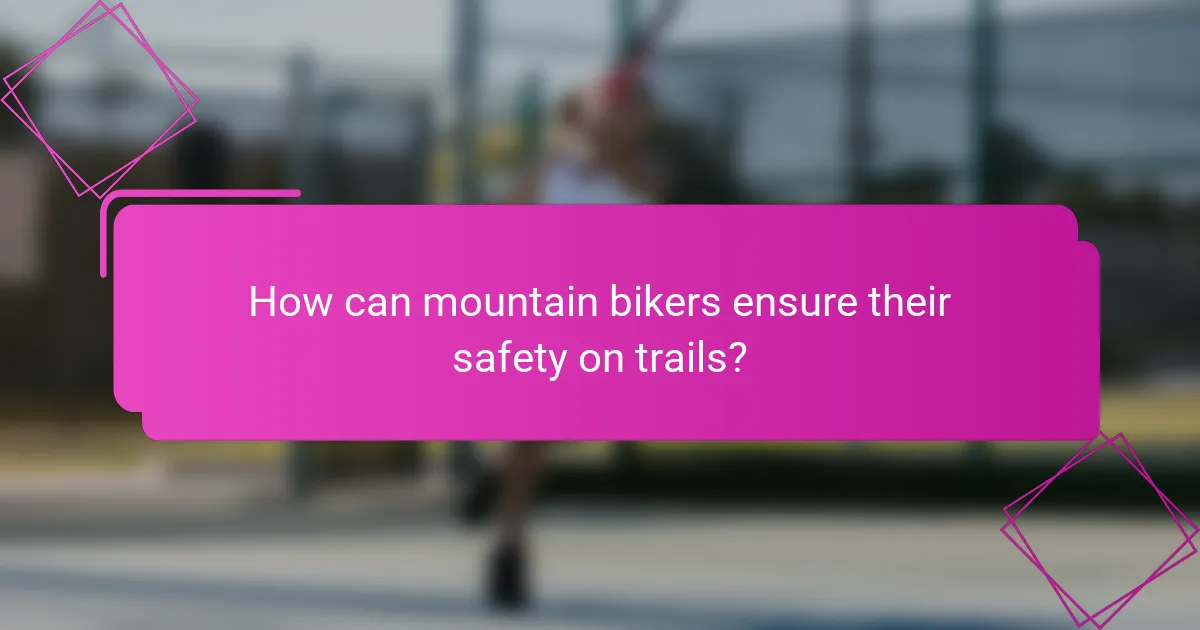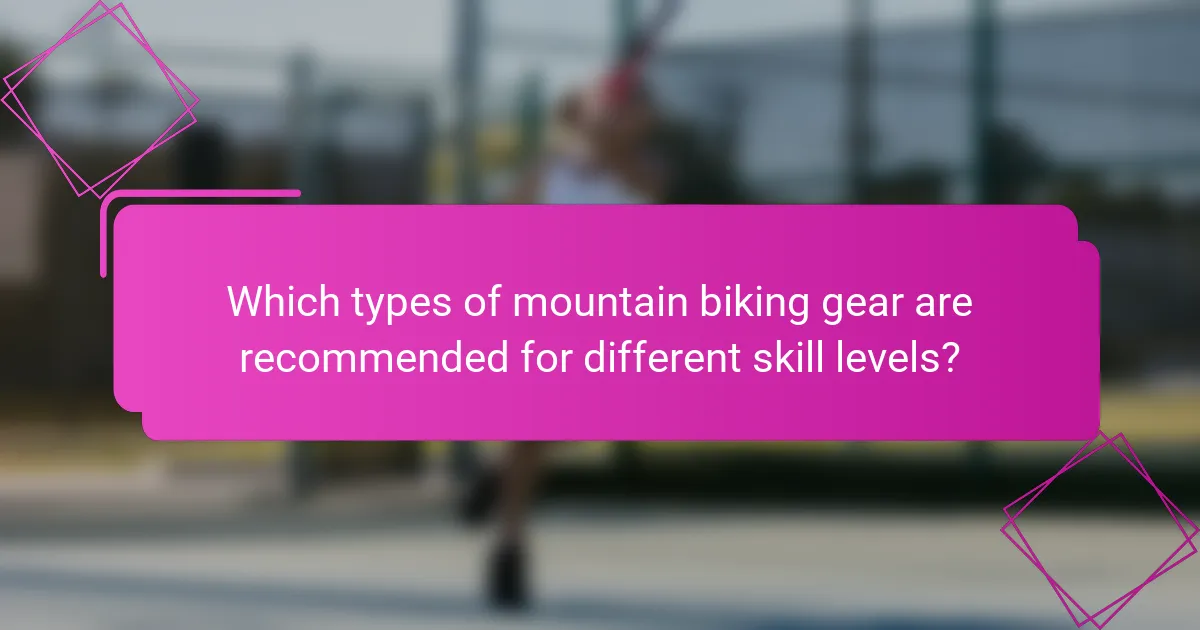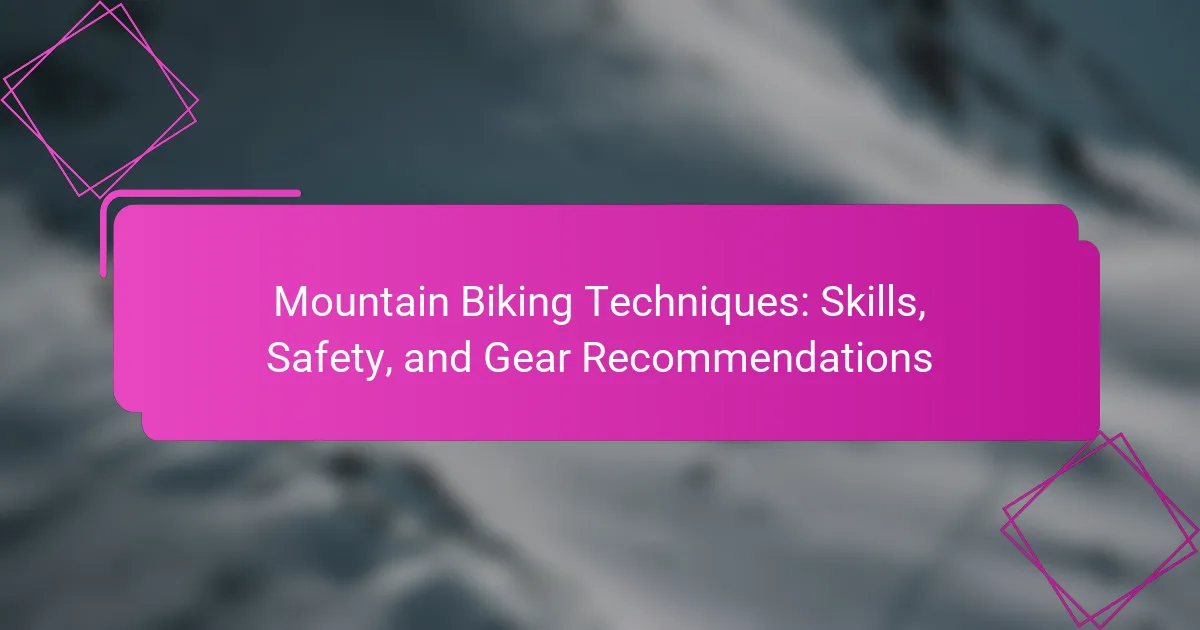Mountain biking offers thrilling challenges and significant psychological benefits, but mastering essential techniques is crucial for safety and enjoyment. This article covers key skills like cornering and climbing, emphasizes the importance of protective gear, and provides tailored gear recommendations for different skill levels. Understanding environmental factors and avoiding common mistakes can further enhance your riding experience and safety on the trails.

What essential skills are required for effective mountain biking?
Effective mountain biking requires skills in balance, bike handling, and navigation. Riders must master techniques like cornering, climbing, and descending. Safety knowledge, including helmet use and trail etiquette, is crucial. Familiarity with gear, such as appropriate bikes and protective equipment, enhances performance and safety.
How can beginners develop their mountain biking skills?
Beginners can develop their mountain biking skills by focusing on technique, safety, and appropriate gear. Start with basic skills like balance and braking, practice on varied terrain, and gradually increase difficulty. Safety gear, including helmets and pads, is essential. Invest in a reliable mountain bike suited to your height and riding style. Join local biking groups for support and tips. Regular practice and seeking feedback will accelerate skill development.
Which advanced techniques enhance performance on challenging trails?
Advanced techniques that enhance performance on challenging trails include proper body positioning, effective braking, and line selection. Mastering these skills improves control and stability.
Body positioning involves keeping a low center of gravity, which enhances balance over rough terrain. Effective braking requires understanding the difference between front and rear brake use to maintain traction. Line selection is crucial for navigating obstacles efficiently, allowing riders to choose the best path for speed and safety.
Practicing these techniques in varied conditions builds confidence and skill, leading to better performance on difficult trails.
What role does body positioning play in mountain biking?
Body positioning is crucial in mountain biking as it affects balance, control, and efficiency. Proper positioning enhances traction and stability on varied terrains. Riders should adjust their stance based on terrain type; for example, leaning back on descents helps maintain control, while a forward position aids in climbing. Effective body positioning can reduce fatigue and the risk of injury, making it a fundamental skill for all mountain bikers.

How can mountain bikers ensure their safety on trails?
Mountain bikers can ensure their safety on trails by wearing protective gear, maintaining their bikes, and following trail etiquette. Protective gear includes helmets, knee pads, and gloves to prevent injuries. Regular bike maintenance, such as checking brakes and tyre pressure, enhances control. Riders should also be aware of their surroundings and yield to others on shared trails.
What safety gear is crucial for mountain biking?
Crucial safety gear for mountain biking includes a helmet, gloves, knee pads, elbow pads, and appropriate footwear. Each piece significantly reduces injury risk during rides.
1. Helmet: Protects the head from impacts.
2. Gloves: Enhance grip and protect hands.
3. Knee Pads: Shield knees from abrasions and impacts.
4. Elbow Pads: Guard elbows against falls.
5. Footwear: Provides traction and support.
Using this gear increases safety and confidence on challenging trails.
How can bikers assess trail conditions for safety?
Bikers can assess trail conditions for safety by checking weather forecasts, trail reports, and local biking forums. They should examine the trail surface for mud, rocks, or debris. Using GPS apps helps track trail conditions and elevation changes. Engaging with local biking communities provides insights into recent trail activity and safety concerns.
What are the best practices for riding in groups?
To ride safely in groups, maintain a steady pace, communicate effectively, and follow established protocols. Ensure spacing between riders to avoid collisions and signal hazards clearly.
1. Ride in a single file on narrow trails.
2. Use hand signals to indicate turns or stops.
3. Call out obstacles and changes in terrain.
4. Keep a consistent speed to maintain group cohesion.
5. Respect the trail and other users.
6. Stay aware of your surroundings at all times.

Which types of mountain biking gear are recommended for different skill levels?
Recommended mountain biking gear varies by skill level. Beginners should focus on a reliable helmet, padded shorts, and gloves for comfort and safety. Intermediate riders can benefit from full-suspension bikes, protective gear, and hydration packs. Advanced bikers may require lightweight gear, high-performance bikes, and specialized accessories for technical trails. Each level emphasizes safety and performance tailored to riding style.
What features should be considered when selecting a mountain bike?
When selecting a mountain bike, consider frame material, suspension type, wheel size, brake system, and fit. These features significantly affect performance and comfort on various terrains.
Frame material impacts weight and durability; aluminium is lightweight, while carbon offers stiffness. Suspension type can be hardtail for efficiency or full-suspension for better control. Wheel size affects stability and manoeuvrability, with 29-inch wheels providing speed and 27.5-inch wheels offering agility. Brake systems, either disc or rim, influence stopping power and maintenance. Finally, proper fit ensures comfort and control during rides.
How do tyre types affect mountain biking performance?
Tyre types significantly influence mountain biking performance by affecting traction, control, and speed. Different tread patterns and rubber compounds cater to specific terrain conditions. For example, wider tyres provide better grip on loose surfaces, while narrower tyres enhance speed on hardpack trails.
Tyre pressure also plays a crucial role; lower pressure increases traction but may sacrifice speed. The choice between tubeless and tubed tyres impacts weight and puncture resistance. Overall, selecting the right tyre type aligns with the rider’s skill level and intended trail conditions.
What accessories enhance the mountain biking experience?
Accessories that enhance the mountain biking experience include protective gear, navigation tools, and hydration systems. Helmets, knee pads, and gloves improve safety and comfort. GPS devices and smartphone mounts aid navigation. Hydration packs ensure riders stay hydrated during long rides. Quality bike lights enhance visibility in low-light conditions. Finally, multi-tools offer on-the-go repairs.

What are the psychological benefits of mountain biking?
Mountain biking offers significant psychological benefits, including reduced stress, improved mood, and enhanced self-esteem. Engaging in this activity promotes mental clarity and fosters a sense of accomplishment. Regular mountain biking can also combat anxiety and depression by providing an outlet for physical exertion. The connection with nature during rides further enhances these mental health benefits, creating a calming effect.
How does mountain biking contribute to physical fitness?
Mountain biking significantly enhances physical fitness by improving cardiovascular endurance, strength, and flexibility. Engaging in this activity regularly can lead to better overall health and increased stamina.
The rigorous nature of mountain biking works various muscle groups, particularly in the legs, core, and upper body. As riders navigate diverse terrains, they build strength and coordination. Additionally, mountain biking can burn approximately 400 to 1000 calories per hour, depending on intensity and rider weight.
Safety is paramount; wearing appropriate gear such as a helmet and protective pads is essential. Proper techniques, like maintaining balance and handling obstacles, further contribute to fitness by ensuring efficient movement and reducing injury risk.
Incorporating mountain biking into a fitness routine not only supports physical health but also promotes mental well-being through outdoor engagement and stress relief.
Which mental strategies can improve focus and enjoyment while riding?
Mental strategies like mindfulness, visualization, and goal-setting can significantly enhance focus and enjoyment while riding. Mindfulness helps maintain awareness of the present moment, reducing distractions. Visualization involves mentally rehearsing rides, which can boost confidence and performance. Goal-setting provides clear objectives, making rides more purposeful and enjoyable.

How do environmental factors influence mountain biking experiences?
Environmental factors significantly impact mountain biking experiences by influencing trail conditions, rider safety, and gear effectiveness. Weather, terrain, and vegetation all affect how riders navigate trails. For example, wet conditions can lead to muddy trails, increasing difficulty and safety risks. Altitude can affect rider endurance and performance, while temperature extremes may require specific gear choices for comfort and safety. Understanding these elements helps riders prepare adequately and enhances their overall experience.
What should bikers know about riding in different weather conditions?
Bikers should adjust their techniques and gear based on weather conditions to ensure safety and performance. In wet conditions, use wider tyres for better grip and reduce speed to avoid skidding. For cold weather, dress in layers to maintain warmth and visibility. In hot conditions, stay hydrated and wear breathable fabrics to regulate body temperature. Always check the weather forecast before heading out to prepare accordingly.
How can trail maintenance impact biking safety and enjoyment?
Trail maintenance significantly enhances biking safety and enjoyment by ensuring clear paths and reducing hazards. Well-maintained trails minimize risks such as loose rocks, fallen branches, and erosion. Regular upkeep promotes a smoother ride, which directly contributes to a more enjoyable biking experience. Additionally, clear signage and trail markings help bikers navigate effectively, fostering confidence and safety. Overall, consistent trail maintenance is essential for an optimal mountain biking experience.

What common mistakes do mountain bikers make and how to avoid them?
Mountain bikers often make mistakes that compromise their skills and safety. Common errors include improper bike setup, neglecting safety gear, and poor riding techniques.
1. Incorrect bike fit can lead to discomfort and reduced control. Ensure the bike is adjusted to your height and riding style.
2. Not wearing a helmet and protective gear increases injury risk. Always wear a helmet, gloves, and pads.
3. Failing to maintain the bike can cause mechanical failures. Regularly check brakes, tyres, and gears.
4. Overlooking terrain awareness can lead to accidents. Always scan the trail for obstacles and changes in elevation.
5. Improper braking techniques can result in loss of control. Use both brakes evenly to maintain stability.
By addressing these common mistakes, mountain bikers can enhance their riding experience and safety.
Which practices can enhance trail etiquette among bikers?
Practices that enhance trail etiquette among bikers include yielding to hikers, maintaining a safe distance from others, and minimizing noise. These actions promote a respectful and enjoyable trail experience for all users. Yielding to hikers ensures safety and fosters goodwill. Keeping a safe distance helps prevent accidents and allows for smoother navigation. Minimizing noise contributes to the natural ambiance of the trail, enhancing the experience for everyone.
How can bikers effectively handle mechanical issues on the trail?
Bikers can effectively handle mechanical issues on the trail by being prepared with essential tools and knowledge. Carry a multi-tool, tyre levers, and a spare tube to address common problems like flat tyres and minor adjustments. Familiarize yourself with basic repairs, such as fixing a flat or adjusting brakes, to minimize downtime. Regularly inspect your bike before rides to identify potential issues, ensuring a smoother experience on the trail.
What are the best tips for improving endurance and stamina in mountain biking?
To improve endurance and stamina in mountain biking, focus on consistent training, proper nutrition, and recovery techniques. Gradually increase ride duration and intensity to build aerobic capacity. Incorporate interval training to enhance power and speed. Hydration is crucial; aim for balanced electrolyte intake. Strength training complements biking by targeting core and leg muscles, improving overall performance.
